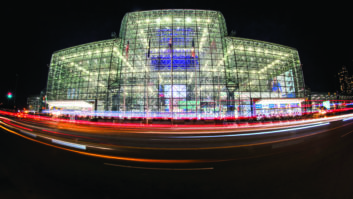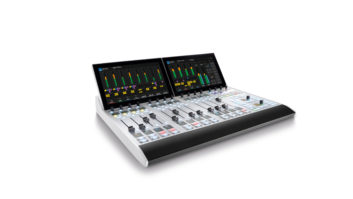
On the Monday morning of the NAB Show, the Broadcast Engineering Conference turns its attention to radio facilities in a group of presentations chaired by Jeff Smith of Clear Channel Radio.
Not long ago, when we used the term “network” around a station, we commonly meant a national source of broadcast programming. In today’s studio and transmission sites, another kind of network has taken root; this is changing not only the way we use the word but the way we operate our facilities.
Studio control boards, remote controls, transmitters and myriad of other devices are interconnected, allowing for remote control and status verification on an unprecedented level. How these devices talk to us, and potentially to each other, are among topics of discussion at the BEC.
Tony Peterle, technical support manager at World Cast Systems Inc., will present “The Smart Site: Integrating Intelligence Into All Facets of the Broadcast Facility.”
When the FCC began to allow for the unattended studio and transmitter facility, it did so knowing that remote controls had progressed to the point where the engineer, if alerted to a compromised condition, could react and, in most cases, remedy the situation enough so as to prevent illegal operation, restore service at least to some degree and even to prevent equipment damage. But for most facilities, it is still a matter of occurrence, diagnosis and human response.
Now we are moving into the next phase of automation, the ability of the equipment not only to query itself but to react immediately, switching to an auxiliary device and notifying a control operator of an out-of-tolerance condition. In addition, the analysis now has the potential to go beyond the traditional parameters of power output, tower lighting alarms, antenna switches and backup systems. Equipment now has a voice to communicate with its peers, via serial or network paths. As manufacturers include means for devices to be networked, and as software is developed to allow for artful interface, “site intelligence” has flipped the task list from the human to the machine, meaning equipment at a smart site can handle a tremendous variety of conditions, correcting for them and notifying the engineer as needed.
Peterle says it is now possible for users to network the studio, the transmitter site and the various support systems that not only transmit but maintain the environmental factors that help to sustain equipment’s longevity and safety. Systems also can keep watch on the traditional points (transmission, temperatures, security) as well as security systems, HVAC, servers, even the quality of the transmission itself, such as a station’s pilot, modulation, or any instability that might occur.

An image from a presentation by Kevin Rodgers of Nautel about monitoring and control. In his paper “Reducing Operating Costs With Better Monitoring and Control of Facilities,” Kevin Rodgers, director of customer service at Nautel, examines it monetarily.
With centralized intelligence effectively monitoring multiple facets of the operation, users can explore ways to reduce expensive operating (and repair) costs. He plans to demonstrate with examples how this can be managed utilizing a TCP/IP backbone. Rodgers asks, “What would you say to a remote control that included spectral analysis, or a Smith Chart function (to view phase rotation)?”
IP remote controlling realizes monitoring in “deep-drill” mode, allowing an engineer to assess conditions from the office or at home, which may save on trips to the transmitter site. He or she can confirm compliance of the signal without having to resort to additional expensive test gear along with the visit.
“Radio in the Cloud” — As networking and the Internet have gained in sophistication, the need for each device on the network to perform every support function decreases, as common tasks can be managed by “the cloud” and an increased amount of applications can be shared, as opposed to unnecessary replication at the local level.
Andrew Janitschek, director of program and operations support for Radio Free Asia, will take us beyond the individual station, showing how networking can be expanded via offsite warehousing of records, logs and source material (i.e., audio).
The “cloud” paradigm allows for a more focused tasking at the local level, leaving general applications to a greater, shared community saving time and labor.
Afternoon: IP audio for radio
Monday afternoon, the Broadcast Engineering Conference turns its attention to IP audio for radio in a set of sessions also chaired by Jeff Smith.
“LANS and Drivers and Fares: Oh My!” — It’s clear that digital audio now reigns supreme in the broadcast plant, and we have some standardization coming about which nudges different products to speak the same language, allowing distribution of digital audio efficiently within and without the facility.
Even in the world of digital communication, talk is not always cheap, as Al Salci, vice president of Sierra Automated Systems warns us in his presentation. He plans to consider proprietary protocols in the IP audio world, many requiring differing fees and fares for licensing, and argues that there is movement afoot to bring these together under a common umbrella, making the transportation of audio more cost-effective.
“The misconception is that there are no proprietary protocols that indeed require drivers to be installed when speaking to other third-party equipment,” he said. “Accordingly, to interface DAWs, a driver must be purchased or licensed, thereby negating the perceived savings of a hardware soundcard.”
With the IEEE close to standardizing 802.1 AVB, Salci said, he will discuss how the standard can provide a plug-and-play process where drivers automatically install and the devices will be ready to communicate without the need for additional licensing costs. Later in the day he will go into more detail of the 802.1 AVB protocol.
“Extending AoIP to the Transmitter” — Kirk Harnack, executive director of international business development at Telos-Omnia-Axia, will discuss and show examples of bringing the remote transmitter site into the LAN; Chuck Kelly, director of sales at Nautel, will co-present and describe the functionality brought by adding Ethernet to modern transmitters, not only for remote control and monitoring, but for linear audio delivery as well.
“FM transmitters are now available with AoIP network connections,” Kelly said. “This implies that, for the first time, audio may be routed from PC playout systems or other sources all the way to the transmitter and be carried in a completely linear format by IP-Audio packets across a qualified Ethernet/IP network.”
Harnack added, “Now virtually all of a radio station facility’s engineering infrastructure can be interconnected using Ethernet/IP. Separate functions and systems such as real-time linear audio transport, audio content backup, IP-video security systems, monitoring and control of studio and transmitter gear, plus Voice-over-IP, or VoIP, and other routine IP traffic can all share a common, ubiquitous transport infrastructure.” Harnack and Kelly will discuss how radio stations are doing this now.
So, we know the transmitter site is humming along well, but what about life at the studio? What can help us create that sound that will make your hardworking talent stand out? And how do we bring this technology into the control room in a way that frees up the creativity and energy?
Patrick Campion, the director of product development at ENCO Systems, will address this point in “Beyond Automation: Intelligent Software Design for Live-Assist Applications.”
Stations want software to “be an aid to the personality, instead of a replacement,” he said. “Software made to be used by humans instead of replacing humans isn’t a new concept, but it’s something that doesn’t get the attention that it deserves.”
Integration of software to simplify the creation of logs and allow for easy access to more devices by more station personnel gives the talent time to focus on the fun and not have to tangle with the tedious aspects of their routines. Intelligent GUI design is one major way to make this happen, he argues.
The evolution of telephone technology has seeped its way into our lives as well, starting with large-scale digital networks connecting coast to coast, to the soon-to-be-ubiquitous AoIP business networks in offices worldwide.
The need to for analog-to-digital conversions over various circuitry paths is becoming a thing of the past, as are bulky and expensive PBXs.
Steve Church, founder and CEO of Telos Systems and recipient of this year’s NAB Radio Engineering Achievement Award, and Michael Dosch, president of Axia Audio, have co-authored “VoIP in the Broadcast Studio,” highlighting the uses of VoIP phone systems and how this has created versatility with direct call traffic within the studio complex, operational flexibility and the move of telephone communication into the next generation with advancements such as Session Initiation Protocol (SIP).
Audio over IP has the potential to reach just about every place on the globe. But as the Internet grows, so does the demand as we discover new and creative things desirable to transport.
Whether it be in a closed network or over the Internet, success will require planning that takes into account capacity, latency and jitter. In the world of broadcasting, where drops and disruptions are not acceptable, some means of backup can be mission-critical.
Greg Massey, chief technical officer for APT, part of WorldCast Systems, will present his talk “Going National: Special Considerations for Large-Scale Deployments of Audio Over IP,” showing ways in which broadcasters have implemented multiple codecs to ship audio between facilities on a continental basis.
He believes that the broadcaster must learn to “think like the telecom ops” when designing the network, keeping in mind peak time, bandwidth fluctuations and other things inherent in the system in which workarounds might be required.
Al Salci of Sierra Automated Systems returns to expand upon an arena of high-bandwidth data transport with “An Introduction to IEEE 802.1 Audio/Video Bridging for Radio Broadcasters.”
This standard was developed by an organization of professional companies dedicated to provide the specifications that will allow time-synchronized low-latency streaming services through IEEE 802 networks. With Apple and Microsoft embracing this standard, “it likely we’ll see the AVB connector on future products such as we see AES or S/PDIF connectors,” Salci said.
Audio over IP is now commonplace in shipping audio from point to point geographically, such as with remote broadcasting and in some cases as an STL. However, these applications require bandwidth for each receiving location. Could AoIP one day replace satellites for simultaneous distribution to multiple users?
WorldCast System’s Rolf Taylor speaks about “Point-to-Point Audio Distribution: It’s Not Just Satellite Anymore.”
One new network type offered by providers, Multiple Protocol Label Switching, may be an answer. Taylor will examine how an MPLS network’s data packets are assigned labels. Packets are forwarded based on the contents of the labels without the need for examination of the packet itself. As a result, end-to-end circuits of any protocol can be used to transport any form of data in a “virtually private” network.
These networks often support IP Multicast, which is designed to transport one stream to multiple locations efficiently without the need for multiple redundant streams. Taylor also covers the topic of Ethernet-IP Address Resolution Protocol and creative use to allow multipoint distribution over simplex media.
Charles Dubé is chief engineer at WFCR(FM), Amherst, Mass.












